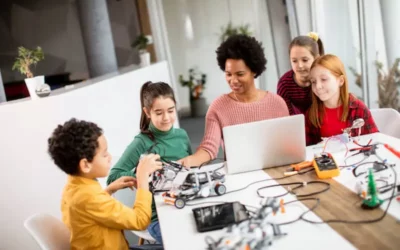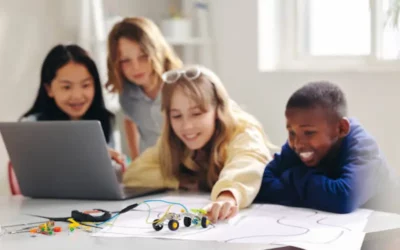Robotics toys for kids are interactive playthings designed to introduce children to the principles of robotics and programming. These educational gadgets often incorporate building components and simple coding interfaces, fostering a hands-on learning experience that sparks curiosity and develops foundational STEM skills from an early age.Robotics toys play a crucial role in child development by promoting critical skills such as problem-solving, creativity, and logical thinking. Engaging with these toys not only introduces kids to technology and programming concepts but also encourages teamwork and perseverance.
In this blog, explore the enriching world of robotics toys for kids. From fostering early STEM interest to nurturing problem-solving skills, these interactive gadgets, like LEGO Mindstorms and Sphero SPRK+, offer a playful gateway to technology and programming education.
Table of contents
- Benefits of Robotics Toys
- Criteria for Selecting Robotics Toys
- Top Picks: Robotics Toys for Different Age Groups
- Educational Robotics Kits
- DIY Robotics Projects for Kids
- Addressing Safety Concerns
- Parental Involvement in Robotic Play
- The Future of Robotics in Education
- Conclusion
- Frequently Asked Questions ( FAQs )
Benefits of Robotics Toys

A. Cognitive Development
Problem-Solving Skills:
- Engaging with robotics toys enhances problem-solving abilities.
- Children learn to analyze challenges and develop effective solutions.
Critical Thinking Abilities:
- Robotics toys stimulate critical thinking by encouraging logical reasoning, fostering the development of essential critical thinking skills for kids.
- Kids develop the capacity to evaluate situations and make informed decisions.
B. STEM Learning
Science:
- Robotics toys introduce scientific concepts, fostering a curiosity for the natural world and making science for kids an engaging and hands-on experience.
- Hands-on experimentation enhances understanding of scientific principles.
Technology:
- Children gain early exposure to technology through interactive play.
- Understanding basic technological concepts sets a foundation for future learning.
Engineering:
- Robotics toys inspire an interest in engineering principles.
- Kids grasp fundamental engineering concepts through assembling and programming.
Mathematics:
- Robotics toys incorporate mathematical elements, making learning math enjoyable and akin to engaging math games for kids.
- Practical application of math concepts promotes a deeper understanding.
Criteria for Selecting Robotics Toys
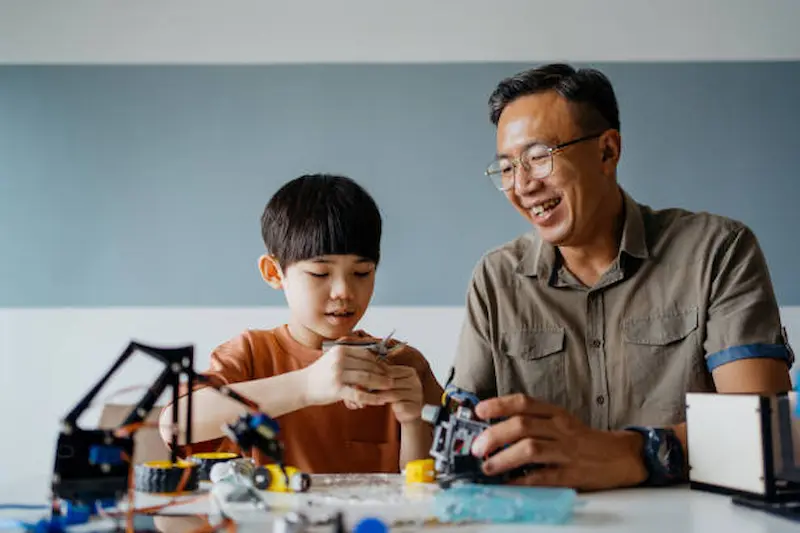
A. Age-Appropriate Features
- Considerations for Different Age Groups:
- Tailor robotics toys to the child’s developmental stage.
- Younger children benefit from tactile features, bright colors, and simple controls.
- Older kids can engage with more complex programming and building components.
- Ensure age-appropriate safety features to prevent hazards during play.
B. Educational Value
- Learning Objectives:
- Choose toys aligned with educational goals, promoting STEM concepts.
- Integrate age-specific challenges to encourage gradual skill progression.
- Select toys that align with school curricula to reinforce classroom learning.
- Skill Development:
- Foster cognitive skills through problem-solving and logical thinking, essential components of child cognitive development.
- Enhance motor skills with hands-on assembly and manipulation, ensuring a holistic learning experience.
- Encourage creativity and innovation by selecting toys that allow for open-ended exploration.
- Support social development by choosing toys that facilitate collaboration and teamwork, promoting communication and interpersonal skills.
- Look for toys that offer opportunities for continuous learning, adapting to the child’s growing abilities and interests over time.
Top Picks: Robotics Toys for Different Age Groups
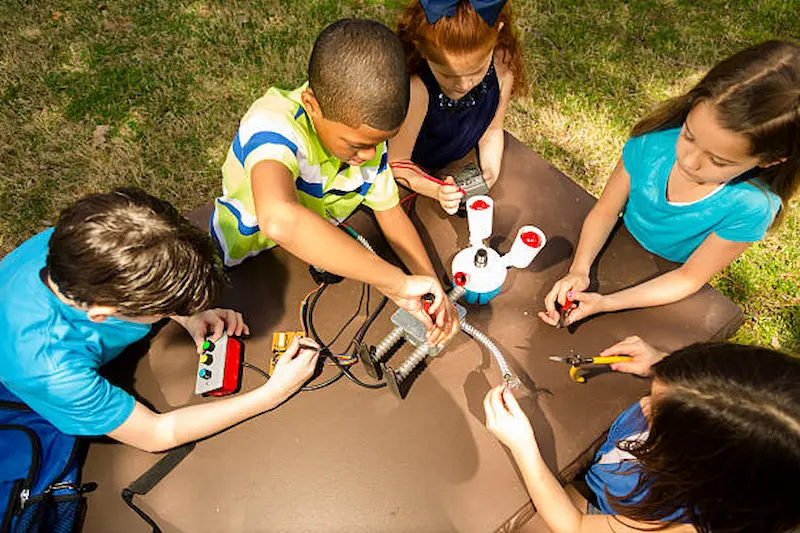
A. Ages 3-5
- Robotics toys for this age group focus on introducing fundamental concepts like shapes, colors, and basic sequencing, making robotics for kids an interactive and educational experience.
- Simple commands promote early understanding of cause and effect.
Safety Considerations:
- Age-appropriate robotics toys prioritize safety features.
- Large, durable pieces minimize choking hazards, ensuring a secure play environment.
B. Ages 6-8
Intermediate Learning:
- Robotics toys for this age range introduce more complex programming concepts.
- Children begin to explore basic coding and logical sequences.
Engaging Activities:
- Interactive challenges and puzzles enhance engagement.
- Multi-functional robotics toys provide a mix of entertainment and educational value.
C. Ages 9-12
Advanced Features:
- Robotics toys for older children incorporate advanced features like sensors and programmable actions.
- Enhanced complexity prepares kids for more sophisticated STEM challenges.
Project-Based Learning:
- Emphasis on project-based learning encourages creativity.
- Kids design and execute their robotic projects, fostering independent problem-solving skills.
Educational Robotics Kits

A. Overview of Popular Kits:
- Educational robotics kits are designed to introduce learners to the fascinating world of robotics and programming, with a notable mention to robotics kits for kids.
- Popular kits include LEGO Mindstorms, VEX Robotics, and Arduino-based kits.
- These kits cater to various age groups and skill levels, fostering a gradual learning curve.
B. Comparison of Features:
- Robotics Components:
- LEGO Mindstorms offers a versatile range of bricks, sensors, and motors for creative builds.
- VEX Robotics emphasizes structural components, promoting engineering and design skills.
- Arduino kits provide flexibility, allowing users to experiment with diverse sensors and actuators.
- Programming Capabilities:
- LEGO Mindstorms employs a visual programming interface, suitable for beginners, making LEGO robotics for kids an accessible and engaging introduction to the world of robotics and programming.
- VEX Coding Studio supports both block-based and text-based programming for a seamless transition.
- Arduino kits utilize C/C++ programming, offering a more advanced coding experience.
- These kits empower students with hands-on learning, fostering critical thinking, problem-solving, and technical skills in an engaging manner.
DIY Robotics Projects for Kids
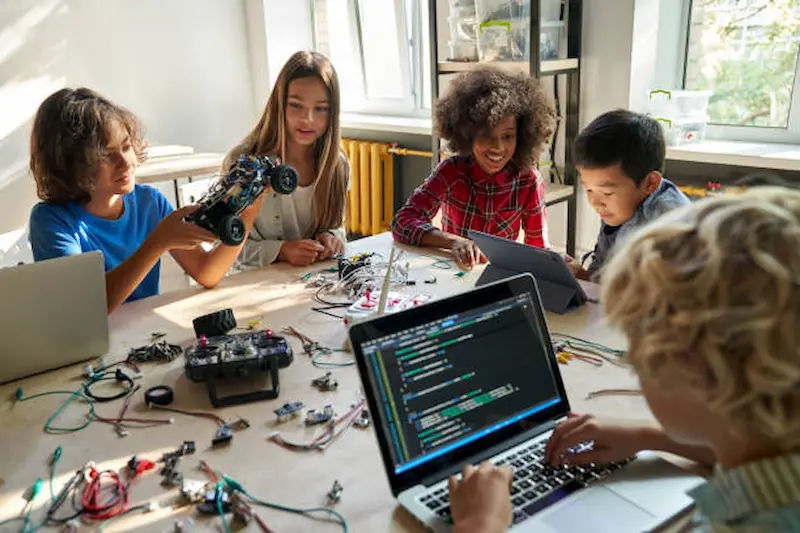
A. Simple Home Projects
Materials Needed:
- Common household items like cardboard, motors, and sensors.
- Promotes resourcefulness and utilization of readily available materials.
- Teaches kids to repurpose items, fostering an eco-friendly mindset.
Step-by-Step Instructions:
- Encourages hands-on learning and problem-solving skills.
- Fosters independence as kids follow detailed instructions to build robots.
- Enhances spatial awareness and fine motor skills during assembly.
- Develops patience and perseverance as they troubleshoot and debug.
B. Benefits of DIY Projects:
- Enhances creativity and critical thinking.
- Develops practical understanding of STEM concepts.
- Instills a sense of accomplishment and boosts confidence.
- Promotes teamwork and collaboration among young learners.
- Lays the foundation for future innovation and technological proficiency.
- Encourages curiosity and a lifelong love for learning in science and engineering.
- Provides a tangible connection between theoretical concepts and real-world applications.
- Fosters adaptability by allowing kids to explore different solutions to problems.
- Strengthens communication skills as children discuss and share ideas during the project.
- Cultivates a sense of responsibility as kids take ownership of their creations from start to finish.
Addressing Safety Concerns

Ensuring safety in robotics is paramount for effective learning experiences, and incorporating child safety tips is integral to this effort. Employing age-appropriate designs and materials minimizes physical risks, ensuring that educational robotics activities are well-suited for children. Strict adherence to safety guidelines during assembly and operation is crucial, emphasizing the importance of precision and care in handling robotic components. Additionally, providing adequate supervision and emphasizing responsible usage fosters a secure learning environment, allowing children to explore the fascinating world of robotics with confidence. Regularly updating and assessing safety protocols ensures that educational robotics activities prioritize the well-being of students, promoting a balance between exploration and precaution in the dynamic realm of hands-on learning.
Parental Involvement in Robotic Play
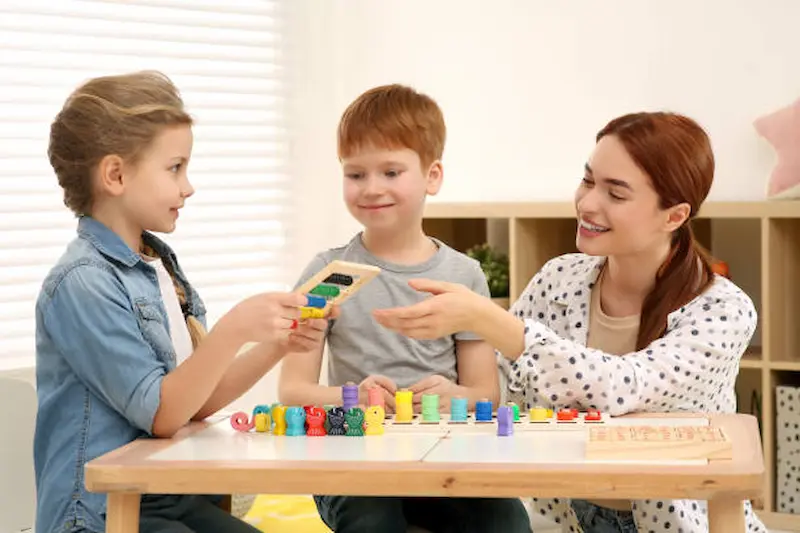
Active parental involvement enhances the benefits of robotic play.
Guidance and Support:
- Parents can offer guidance, providing essential parenting advice, and helping children understand complex concepts and overcome challenges.
- Collaborative play fosters a positive learning environment.
Bonding Opportunities:
- Robotic play becomes a shared experience, strengthening the parent-child bond.
- Collaborative problem-solving builds communication skills and encourages teamwork, essential components in nurturing leadership skills for kids.
- By engaging in activities that require joint effort and effective communication, children not only develop the ability to work harmoniously with their peers but also cultivate the foundational skills needed for effective leadership.
Safety Supervision:
- Parents ensure a safe play environment, monitoring for potential hazards.
- Supervision ensures that children derive maximum educational value while staying secure during robotic activities.
The Future of Robotics in Education
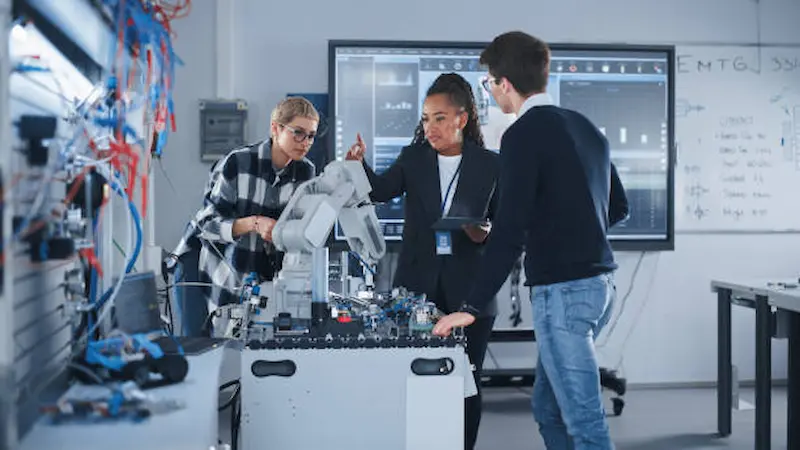
A. Emerging Trends:
- Personalized Learning Paths:
Robotics is set to revolutionize education by offering personalized learning paths, extending its impact to early childhood learning. This means that students, including those in their formative years, can benefit from a curriculum that caters specifically to their individual learning styles and preferences, fostering a more effective educational experience.
- Inclusivity Focus:
The future of robotics in education emphasizes inclusivity. Robotics will play a pivotal role in catering to diverse learners, ensuring that educational tools and approaches are accessible and effective for students with varying needs and abilities.
B. Potential Advancements:
- AI Integration:
As we look ahead, there’s a clear trajectory towards deeper integration of artificial intelligence in educational robotics, including AI for kids. This integration will enable a more adaptive and personalized learning environment, where AI algorithms can understand and respond to individual student progress and needs.
- Real-World Applications:
The future promises a shift towards robotics with practical applications, including exciting robotics projects for kids. Beyond theoretical knowledge, students will engage with robotics that have real-world relevance, preparing them for challenges they may encounter in various industries. This shift will not only enhance their problem-solving skills but also bridge the gap between academic learning and practical, hands-on experience, better preparing them for the demands of the future workforce.
Conclusion
Robotics toys for kids are interactive devices designed to introduce children to the fundamentals of robotics and programming. These toys not only entertain but also provide educational benefits, fostering critical thinking, problem-solving skills, and a foundation in STEM disciplines from an early age. These toys, such as LEGO Mindstorms and Ozobot, engage children in hands-on learning, promoting creativity and teamwork as they build and program their own robots, laying the groundwork for future technological literacy and innovation.
Elevate your child’s learning journey with BrightChamps, the leading EdTech company offering a transformative blend of robotics, financial education, and coding courses.
To get your hands on more such articles, educational content, and free resources on coding for kids, robotics courses, game development, etc., check out the BrightCHAMPS Blog Page now!
Frequently Asked Questions ( FAQs )
A1. Introduce robotics toys to children around 6 years old, fostering early STEM interest.
Q2. How do robotics toys contribute to STEM education?
A2. Robotics toys enhance STEM education by promoting hands-on problem-solving and critical thinking skills.
Q3. Are there any safety concerns with robotics toys?
A3. Safety concerns with robotics toys include small parts, electrical components; supervision is crucial.
Q4. What features should parents consider when choosing robotics toys?
A4. Parents should consider age-appropriate complexity, safety features, and educational value in robotics toy selection.
Q5. How can parents actively participate in their child’s robotics play?
A5. Actively participate by assisting with assembly, discussing concepts, and fostering a supportive learning environment.

 We are an army of educators and passionate learners from BrightChamps family, committed to providing free learning resources to kids, parents & students.
We are an army of educators and passionate learners from BrightChamps family, committed to providing free learning resources to kids, parents & students.




